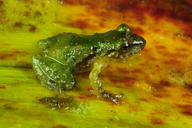|
Pristimantis achupalla Ttito & Catenazzi, 2021
| family: Strabomantidae genus: Pristimantis |
| Species Description: Ttito A and Catenazzi A. 2021. Pristimantis achupalla sp. n., a new minute species of direct-developing frog (Amphibia, Anura, Strabomantidae) inhabiting bromeliads of the montane forest of the Amazonian Andes of Puno, Peru. PeerJ 9:e11878 | |
 © 2021 Alessandro Catenazzi (1 of 12) |
|
|
|
Description DIAGNOSIS: Pristimantis achupalla is morphologically similar to multiple species such as P. acuminatus, P. enigmaticus, P. galdi, P. lacrimosus (variable), P. limoncochensis, P. mendax, P. moro, P. olivaceus, P. omeviridis, P. padiali, P. pardalinus, P. pluvialis, P. rhodostichus, P. schultei, and P. tantanti. The characteristics that these species share include dorsolaterally compressed heads and bodies and papilla or tubercles on the rostrum. However, P. achupalla has a smaller snout-vent length, rugose skin that extends on to the hindlimbs, and larger tubercles on the upper eyelid. Seven other species are particularly similar in appearance. However, P. achupalla can be differentiated by the presence of a supratympanic fold in P. amaguanae, a smooth dorsum and lack of a dermal fold in P. bromeliaceus, smooth skin with a tarsal fold and no tubercles on the upper eyelid in P. enigmaticus, smooth skin without dorsolateral folds, but with a tarsal fold, and a lack of a tympanic membrane and annulus in P. limoncochensis, lack of tubercles on the upper eyelid in P. omevirdis, skin texture and coloration in P. schultei, and shagreen skin with elongated ulnar tubercles in P. tantanti (Ttito and Catenazzi 2021). COLORATION: In life, the dorsum of the frog has greenish-brown pigmentation. A dark brown interorbital bar is present, forming a triangular shape to the posterior. The canthus rostralis is dark greenish brown and the upper eyelids are dark green. The hind and forelimbs are green with the exception of oblique, brown, blurred bars. The throat and the ventrum have a pale green coloration. The iris has dark-brown reticulations on a bronze background. In preservative, The dorsal surface of the head is brown and the body is cream with slight dark brown areas around the scapulae. The interorbital bar is brown, the canthus is dark brown, and the upper eyelids are a dark bluish color. The transverse hindlimb bars remain dark. The ventral surface of the body is cream while the ventral surfaces of the thighs, plantar, palms, and digits become pale green. The tubercles are darker gray. The iris becomes dark gray (Ttito and Catenazzi 2021). VARIATION: There are variations in coloration and skin texture. Some individuals have interorbital bars that range from a brown hue to a cream-like color. Some individuals have fainter brown barring on the hind limbs. Scattered tubercles on the dorsal surfaces can be found on some individuals, while others just have rough skin texture. Sexual dimorphism could not be assessed at the time of the species description as no female specimens were collected (Ttito and Catenazzi 2021). Distribution and Habitat Country distribution from AmphibiaWeb's database: Peru
Life History, Abundance, Activity, and Special Behaviors Other species found in the area included what is presumed to be Gastrotheca testudinea, Pristmantis platydactylus, Psychrophrynella glauca and Noblella thiuni (Tito and Catenazzi 2021). Trends and Threats Possible reasons for amphibian decline General habitat alteration and loss Comments PHYLOGENETIC RELATIONSHIPS: Maximum Likelihood analysis of 16S rRNA found that P. achupalla is most closely related to an undescribed species, and together they are sister to P. amaguanae. The next most closely related species is P. moro (Ttito and Catenazzi 2021). ETYMOLOGY: The species epithet, “achupalla” is a noun in the Quechua language meaning “bromeliads”, and is in reference to the species’ use of bromeliads microhabitats (Ttito and Catenazzi 2021).
References
Ttito, A. and Catenazzi, A. (2021). "Pristimantis achupalla sp. n., a new minute species of direct-developing frog (Amphibia, Anura, Strabomantidae) inhabiting bromeliads of the montane forest of the Amazonian Andes of Puno, Peru." PeerJ 9, e11878 [link] Originally submitted by: Elian De Los Santos (2023-01-18) Description by: Elian De Los Santos, Ann T. Chang (updated 2023-01-18)
Distribution by: Elian De Los Santos (updated 2023-01-18)
Life history by: Ann T. Chang (updated 2023-01-18)
Trends and threats by: Ann T. Chang (updated 2023-01-18)
Comments by: Ann T. Chang (updated 2023-01-18)
Edited by: Ann T. Chang (2023-01-18) Species Account Citation: AmphibiaWeb 2023 Pristimantis achupalla <https://amphibiaweb.org/species/9438> University of California, Berkeley, CA, USA. Accessed May 5, 2025.
Feedback or comments about this page.
Citation: AmphibiaWeb. 2025. <https://amphibiaweb.org> University of California, Berkeley, CA, USA. Accessed 5 May 2025. AmphibiaWeb's policy on data use. |


 Map of Life
Map of Life